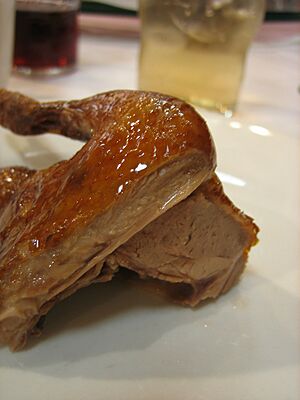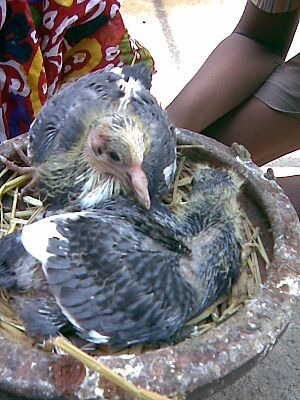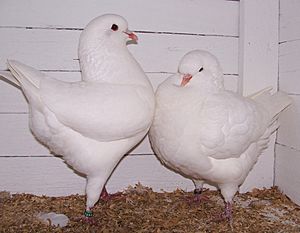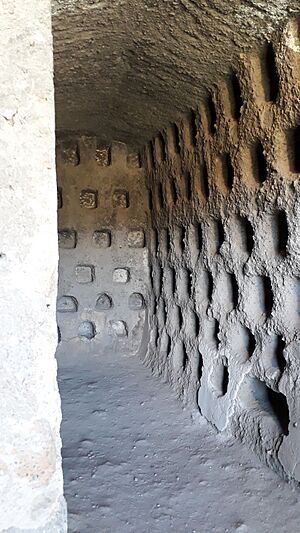Squab facts for kids
Squab is a young domestic pigeon, usually less than a month old, raised for its meat. Many people say it tastes like dark chicken. The name "squab" might come from a Swedish word meaning "loose, fat flesh."
For a long time, the word "squab" was used for any young dove or pigeon. But today, it almost always means meat from pigeons raised on farms. Pigeons hunted for sport are rarely called squab.
People have been raising pigeons for food for thousands of years, possibly starting in North Africa. Ancient civilizations like ancient Egypt, Rome, and China all ate squab. Even though it has a long history, squab is often seen as a special food, not something people eat every day. It was often prepared for wealthy people more than for the poor.
Today, the squab industry uses special kinds of pigeons called "utility pigeons." These young pigeons are raised until they are about a month old. At this age, they are full-grown but haven't flown yet, which makes them easier to prepare for food.
A Look Back: The History of Squab
People started raising pigeons for food a long time ago, possibly in North Africa. Many ancient civilizations, including ancient Egypt, ancient Rome, and Medieval Europe, ate squab. Ancient writings from Spain, around the year 60 AD, describe how to raise pigeons for meat. These birds were hunted because they were a cheap and easy way to get protein.
In a part of Spain called Tierra de Campos, where food was scarce, squab meat was an important addition to grain crops since Roman times. An old Roman doctor thought squab could cure headaches, but later, by the 1500s, people believed it caused them!
During the Middle Ages, a dovecote (a building for pigeons) was common on farms that wanted to produce all their own food. The dovecote was like a "living pantry," providing meat for unexpected guests. Selling extra birds also helped farmers earn money. Dovecotes were brought to South America and Africa by settlers from the Mediterranean region. In medieval England, squab meat was highly valued, but its availability depended on the time of year.
In England, people ate pigeon meat when other foods were rationed during World War II. Because of this, some older people still connect pigeon meat with wartime shortages and poverty. Even so, many people, especially older generations, continue to enjoy it.
How Squab is Raised (Husbandry)
Raising squab for sale started in North America in the early 1900s. By 1986, about 1.5 million squabs were produced each year in the United States and Canada.
Unlike other farm birds, pigeons form pairs to have babies. Both parent pigeons must feed their young until they are about four weeks old. A pair of pigeons can produce about 15 squabs in a year. Ten pairs of pigeons can produce eight squabs every month without needing to be fed by their owners. Pigeons that are used to their dovecote will often fly out to find food and then return there to rest and breed.
Pigeons raised on large farms have young that weigh about 1.3 pounds (0.6 kg) when they are ready. Pigeons raised in more traditional ways usually weigh about 0.5 pounds (0.2 kg).
Special "utility pigeons" have been chosen over many generations to grow quickly, gain weight, and stay healthy even when many are kept together. Their babies are also selected to be healthy. To get more squabs, some farms use a "two-nest system." In this system, the mother lays new eggs in a second nest while her first babies are still growing in the first nest. Both parents feed the babies with a special "crop milk." Another idea for more squabs is to have two different groups of breeding pigeons: one group chosen for having many babies, and another chosen for being good parents. Being good parents is very important for squab growth after two weeks old.
About 15-20% of pigeon eggs do not hatch, even in well-kept pigeon homes. The size of the egg is important for how big the squab is when it hatches and for its survival at birth. However, egg size becomes less important as the squab gets older. The weight of a squab when it hatches is not a good sign of how much it will weigh at four weeks old.
Squabs grow to adult size in about a month, but they are not yet ready to fly. This makes them easier to catch. At this point, they are prepared for food.
Squab in the Kitchen (Cuisine)
| Nutritional value per 100 g (3.5 oz) | |
|---|---|
| Energy | 594 kJ (142 kcal) |
|
0.00
|
|
| Dietary fiber | 0.0 |
|
7.50
|
|
| Saturated | 1.96 |
| Monounsaturated | 2.66 |
| Polyunsaturated | 1.60 |
|
Protein
|
17.50
|
| Vitamins | Quantity
%DV†
|
| Vitamin A equiv. |
4%
28 μg |
| Vitamin A | 94 IU |
| Thiamine (B1) |
25%
0.283 mg |
| Riboflavin (B2) |
24%
0.285 mg |
| Pantothenic acid (B5) |
16%
0.787 mg |
| Vitamin B6 |
41%
0.53 mg |
| Folate (B9) |
2%
7 μg |
| Vitamin B12 |
20%
0.47 μg |
| Vitamin C |
9%
7.2 mg |
| Minerals | Quantity
%DV†
|
| Calcium |
1%
13 mg |
| Iron |
35%
4.51 mg |
| Magnesium |
7%
25 mg |
| Manganese |
1%
0.019 mg |
| Phosphorus |
44%
307 mg |
| Potassium |
8%
237 mg |
| Sodium |
3%
51 mg |
| Zinc |
28%
2.7 mg |
| Other constituents | Quantity |
| Water | 72.80 |
|
There is some variation in nutritional content depending on the breed of utility pigeon used for squabbing.
|
|

Squab is often seen as a special treat. It is tender, moist, and has a richer taste than many other common poultry meats. However, there isn't a lot of meat on each bird; most of the meat is in the breast.
Squab meat is dark meat, and its skin is fatty, similar to duck. The meat itself is very lean, easy to digest, and "rich in proteins, minerals, and vitamins." People describe its texture as "silky" because it's very tender and fine-grained. It has a milder taste than other wild game and has even been described as having a mild berry flavor. Squab's flavor goes well with complex red or white wines. A cooking guide from 1997 warns that if squab is cooked past medium-rare, its flavor can become "livery" (like liver).
In a 14th-century health book, squab was thought to be a "hot and moist" food. But the meat from older pigeons was considered hot, dry, and "barely edible." An ancient Roman cookbook suggested using sweet and sour sauces with roasted or braised squab. In 1607, a monastery cookbook suggested cooking squab with pork fat or bitter limes. We don't have as much information about traditional recipes used by common people, but it's believed these recipes were "handed down from generation to generation."
In the 15th century, an Italian friar wrote a book of "culinary secrets" that included "How to Kill a Squab by Hitting with a Feather on the Head." Squab was a common food in Italy, especially in the Umbria and Tuscan regions, even before the Medieval era. In 18th-century France, a popular dish called pigeons à la crapaudine ("toad-like squab") was enjoyed by both rich and poor. In this dish, the squab was arranged to look like a frog, with the breast forming the frog's "face." This was a clever way to get around old religious rules that banned meat on fast days but allowed frog meat, since frogs live in water. Pigeons à la crapaudine is still a part of French traditional cooking today.
A 19th-century recipe from California for Pastales de pollos y pichones (Chicken and squab pastry) was a savory pie. It had layers of chicken and squab mixed with minced veal, bacon, and ham fried with onion, mushrooms, apples, artichokes, tomatoes, and seasonings.
Squabs raised on farms cook in about half the time as traditionally raised birds. They are good for roasting, grilling, or searing. Traditionally raised birds are better for casseroles and slow-cooked stews. The meat from older and wild pigeons is much tougher than squab. It needs to be stewed or roasted for a long time to become tender. People probably started eating squab because young birds that haven't flown yet are easier to catch and have more tender meat. Once a squab learns to fly, its weight drops a lot.
Today, squab is eaten in many countries, including France, Egypt, the United States, Italy, Northern Africa, and several Asian countries. Some common dishes include breast of squab (sometimes called salmis in French), Egyptian Mahshi (squab stuffed with rice or Freekeh and herbs), Assamese pigeon curry, and the Moroccan pastilla. In Spain and France, squab is also preserved as a confit. Even though it's more expensive than beef, pork, or chicken, more people in Nigeria are wanting squab. This is because pigeons can be raised to eating size quickly and are easy to keep, as long as diseases are controlled, since young pigeons can get sick easily.
In the United States, squab is becoming more of a "specialty item." Larger and cheaper chicken has mostly replaced it. However, squab from specially raised pigeons is still found on the menus of fancy French restaurants like Le Cirque and the French Laundry. Some famous chefs also recommend it. Because of this, squab is often sold for much higher prices than other poultry, sometimes as much as eight USD per pound.
In Indian cuisine, squab is very important in the Northeast, especially in Assamese cuisine. Pigeon is usually cooked as a curry and sometimes with banana blossom. It's popular with both tribal and non-tribal groups. Pigeon meat is linked to strength, and an old text from the region also suggests it for health. Pigeons are sometimes sacrificed in some Hindu temples, especially in the Shakta tradition, like the Kamakhya Temple in India. After the sacrifice, the meat can be eaten. A similar practice happens in Nepal. Pigeon curry is often saved for special occasions.
In Chinese cuisine, squab is part of celebration meals for holidays like Chinese New Year, usually deep-fried. Cantonese-style pigeon is often cooked in soy sauce, rice wine, and star anise, then roasted until the skin is crispy and the meat is tender. Squabs are sold live in Chinese markets to make sure they are fresh. They can also be prepared in two ways: "Chinese-style" (Buddhist slaughter) birds keep their head and feet, while "New York-dressed" (Confucian slaughter) birds keep their insides, head, and feet. Most of the squab sold in the U.S. today is in Chinatowns.
In Indonesian cuisine, especially Sundanese and Javanese food, squab is usually seasoned with spices like coriander, turmeric, and garlic. Then it's deep-fried in a lot of palm oil. It's served with sambal (chili sauce), tempeh, tofu, vegetables, and nasi timbel (rice wrapped in a banana leaf).
Even though raising pigeons is relatively easy, squab is "not usually considered" as a way to help with food security. In some parts of the world, people don't like squab meat because they see feral pigeons (wild pigeons in cities) as dirty city pests. However, squab meat is thought to be safer than some other poultry because it has fewer harmful germs. It can be served anywhere from medium-rare to well done.





